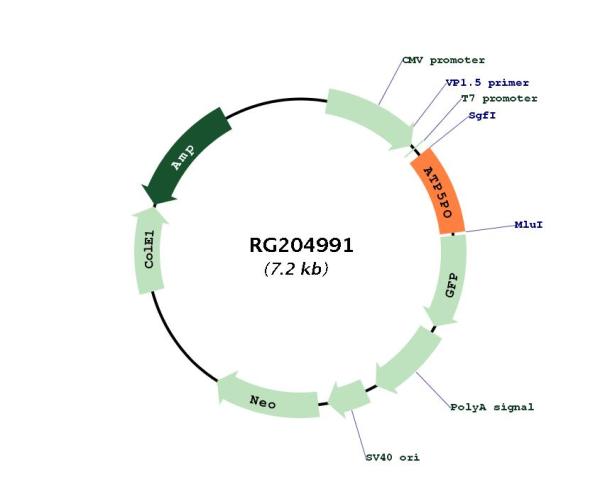ATP5PO (NM_001697) Human Tagged ORF Clone
CAT#: RG204991
- TrueORF®
ATP5O (tGFP-tagged) - Human ATP synthase, H+ transporting, mitochondrial F1 complex, O subunit (ATP5O), nuclear gene encoding mitochondrial protein
ORF Plasmid: DDK
Lentiviral Particles: DDK DDK w/ Puro mGFP mGFP w/ Puro
AAV Particle: DDK
"NM_001697" in other vectors (6)
Specifications
| Product Data | |
| Type | Human Tagged ORF Clone |
| Tag | TurboGFP |
| Symbol | ATP5PO |
| Synonyms | ATP5O; ATPO; HMC08D05; OSCP |
| Vector | pCMV6-AC-GFP |
| E. coli Selection | Ampicillin (100 ug/mL) |
| Mammalian Cell Selection | Neomycin |
| Sequence Data |
>RG204991 representing NM_001697
Red=Cloning site Blue=ORF Green=Tags(s) TTTTGTAATACGACTCACTATAGGGCGGCCGGGAATTCGTCGACTGGATCCGGTACCGAGGAGATCTGCC GCCGCGATCGCC ATGGCTGCCCCAGCAGTGTCCGGGCTCTCCCGGCAGGTGCGATGCTTCAGTACCTCTGTGGTCAGACCAT TTGCCAAGCTTGTGAGGCCTCCTGTTCAGGTATACGGTATTGAAGGTCGCTATGCCACAGCTCTTTATTC TGCTGCATCAAAACAGAATAAGCTGGAGCAAGTAGAAAAGGAGTTGTTGAGAGTAGCACAAATCCTGAAG GAACCCAAAGTGGCTGCTTCTGTTTTGAATCCCTATGTGAAGCGTTCCATTAAAGTGAAAAGCCTAAATG ACATCACAGCAAAAGAGAGGTTCTCTCCCCTCACTACCAACCTGATCAATTTGCTTGCTGAAAATGGTCG ATTAAGCAATACCCAAGGAGTCGTTTCTGCCTTTTCTACCATGATGAGTGTCCATCGCGGAGAGGTACCT TGCACAGTGACCTCTGCATCTCCTTTAGAAGAAGCCACACTCTCTGAATTAAAAACTGTCCTCAAGAGCT TCCTAAGTCAAGGCCAAGTATTGAAATTGGAGGCTAAGACTGATCCGTCAATCTTGGGTGGAATGATTGT GCGCATTGGCGAGAAATATGTTGACATGTCTGTCAAGACCAAGATTCAGAAGCTGGGCAGGGCTATGCGG GAGATTGTC ACGCGTACGCGGCCGCTCGAG - GFP Tag - GTTTAA >RG204991 representing NM_001697
Red=Cloning site Green=Tags(s) MAAPAVSGLSRQVRCFSTSVVRPFAKLVRPPVQVYGIEGRYATALYSAASKQNKLEQVEKELLRVAQILK EPKVAASVLNPYVKRSIKVKSLNDITAKERFSPLTTNLINLLAENGRLSNTQGVVSAFSTMMSVHRGEVP CTVTSASPLEEATLSELKTVLKSFLSQGQVLKLEAKTDPSILGGMIVRIGEKYVDMSVKTKIQKLGRAMR EIV TRTRPLE - GFP Tag - V |
| Restriction Sites |
SgfI-MluI
Cloning Scheme for this gene
Plasmid Map

|
| ACCN | NM_001697 |
| ORF Size | 639 bp |
| OTI Disclaimer | The molecular sequence of this clone aligns with the gene accession number as a point of reference only. However, individual transcript sequences of the same gene can differ through naturally occurring variations (e.g. polymorphisms), each with its own valid existence. This clone is substantially in agreement with the reference, but a complete review of all prevailing variants is recommended prior to use. More info |
| OTI Annotation | This clone was engineered to express the complete ORF with an expression tag. Expression varies depending on the nature of the gene. |
| Product Components | The ORF clone is ion-exchange column purified and shipped in a 2D barcoded Matrix tube containing 10ug of transfection-ready, dried plasmid DNA (reconstitute with 100 ul of water). |
| Reconstitution | 1. Centrifuge at 5,000xg for 5min. 2. Carefully open the tube and add 100ul of sterile water to dissolve the DNA. 3. Close the tube and incubate for 10 minutes at room temperature. 4. Briefly vortex the tube and then do a quick spin (less than 5000xg) to concentrate the liquid at the bottom. 5. Store the suspended plasmid at -20°C. The DNA is stable for at least one year from date of shipping when stored at -20°C. |
| Reference Data | |
| RefSeq | NM_001697.1 |
| RefSeq Size | 815 bp |
| RefSeq ORF | 642 bp |
| Locus ID | 539 |
| UniProt ID | P48047 |
| Cytogenetics | 21q22.11 |
| Domains | OSCP |
| Protein Pathways | Alzheimer's disease, Huntington's disease, Metabolic pathways, Oxidative phosphorylation, Parkinson's disease |
| Gene Summary | The protein encoded by this gene is a component of the F-type ATPase found in the mitochondrial matrix. F-type ATPases are composed of a catalytic core and a membrane proton channel. The encoded protein appears to be part of the connector linking these two components and may be involved in transmission of conformational changes or proton conductance. [provided by RefSeq, Jul 2008] |
Documents
| Product Manuals |
| FAQs |
| SDS |
Resources
Other Versions
| SKU | Description | Size | Price |
|---|---|---|---|
| RC204991 | ATP5O (Myc-DDK-tagged)-Human ATP synthase, H+ transporting, mitochondrial F1 complex, O subunit (ATP5O), nuclear gene encoding mitochondrial protein |
USD 300.00 |
|
| RC204991L1 | Lenti ORF clone of Human ATP synthase, H+ transporting, mitochondrial F1 complex, O subunit (ATP5O), nuclear gene encoding mitochondrial protein, Myc-DDK-tagged |
USD 600.00 |
|
| RC204991L2 | Lenti ORF clone of Human ATP synthase, H+ transporting, mitochondrial F1 complex, O subunit (ATP5O), nuclear gene encoding mitochondrial protein, mGFP tagged |
USD 600.00 |
|
| RC204991L3 | Lenti ORF clone of Human ATP synthase, H+ transporting, mitochondrial F1 complex, O subunit (ATP5O), nuclear gene encoding mitochondrial protein, Myc-DDK-tagged |
USD 600.00 |
|
| RC204991L4 | Lenti ORF clone of Human ATP synthase, H+ transporting, mitochondrial F1 complex, O subunit (ATP5O), nuclear gene encoding mitochondrial protein, mGFP tagged |
USD 600.00 |
|
| SC119088 | ATP5O (untagged)-Human ATP synthase, H+ transporting, mitochondrial F1 complex, O subunit (ATP5O), nuclear gene encoding mitochondrial protein |
USD 300.00 |
{0} Product Review(s)
Be the first one to submit a review






























































































































































































































































 Germany
Germany
 Japan
Japan
 United Kingdom
United Kingdom
 China
China

